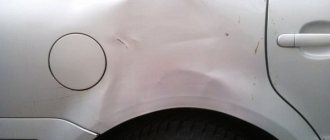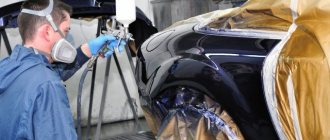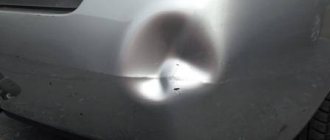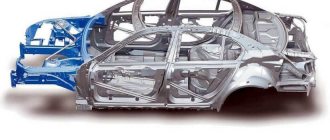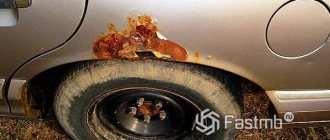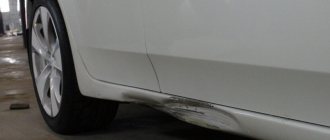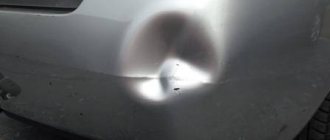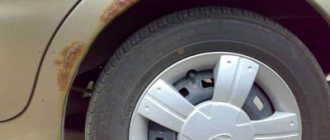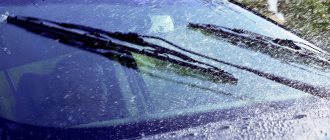What dents can be repaired without painting?
Without painting the car, you can only repair those damages in which the paint layer has not ruptured. The work order will vary depending on the body type. For steel, aluminum and plastic curtain panels, repair methods and material selection will remain different. The following defects can be corrected on a car fender without painting:
- Dents of firecracker on steel and plastic fender. Tinsmiths use this term to call damage to a large area but minimal depth. The defect does not tear the paintwork layer, the metal does not experience twisting.
- Concavities with a diameter of up to 1.5 cm, a depth of up to 1 cm. Damage that is insignificant at first glance remains the most difficult to repair due to the fact that the dent often has a sharp edge. In 70% of cases, after drawing, the aluminum wing is sanded and painted. Steel and plastic in half of the options are drawn without painting using PDR technology.
https://youtu.be/Bi8DUAqmYIY
Devices and materials for stretching car fenders
When working on wing straightening you will need:
- hydraulic or rack jack;
- extensions for jacks (pieces of pipe of different shapes for each type of jack);
- straightening hammer with support;
- wooden bars.
Having installed the jack under the base of the car, you first need to remove the wheel. Then, applying support from the front side of the wing, you need to lightly tap the hammer to straighten out the dent from inside the wing. The main thing here is not to overdo it, since the metal can stretch, and with the slightest push on an uneven surface the wing can bend again.
When starting to stretch the wing with your own hands, you should remember that straightening should begin from the edges of the dent and move towards the center in a spiral. When straightening is completed, you can begin filling and tinting with carefully selected paint. But it is not always necessary to touch up a dented wing. For minor damage, sometimes it is enough to hit the inside several times with a hammer with a rubberized tip. This way you will save money on repairing your car.
Remember, when working with tools during repairs, you must strictly adhere to safety regulations!
Forget about fines from cameras! An absolutely legal new product - Traffic Police Camera Jammer, hides your license plates from the cameras that are installed in all cities. More details at the link.
- Absolutely legal (Article 12.2);
- Hides from photo and video recording;
- Suitable for all cars;
- Works through the cigarette lighter connector;
- Does not cause interference to radios and cell phones.
Rules for straightening a dent
In order for self-straightening of the metal to proceed as quickly and cost-effectively as possible, drivers need to remember the rules that apply to any type of defect, regardless of what material the wing is made of.
- Unevenness must be straightened immediately after it occurs. This will allow you to quickly identify damage to the paintwork, microcracks, which will cause further corrosion of the metal.
- Parts made of stamped steel have the design parameters of metal rigidity laid down by the manufacturer. During deformation, a rupture occurs in the crystal lattice and after some time new molecular bonds begin to form. Repair is made more difficult by the new quality of steel.
- Straightening metal during repairs with painting or drawing without painting is easier to carry out if the wing has a temperature of 40 degrees or more.
- Removing several defects begins with processing the smallest one. This rule applies to both plastic and steel fenders.
- A dent at the edge of the wing, on the line of rigidity, is more difficult to straighten than in the central part due to the increased density of the metal.
Spotter for car straightening
Body repairs, including straightening, can be performed using resistance welding. In this case, a spotter is used as a tool - fasteners are welded onto the deformed surface, with the help of which the metal is pulled out. If in the standard method to level the surface it is necessary to tap the iron from the inside, then thanks to contact welding and a special device the metal surface is leveled from the outside.
Using a spotter provides certain advantages:
- using resistance welding is safer than using a conventional welding machine; practically no sparks fly from it;
- no scale or slag is formed at the welding site; the welding machine does not even burn through thin metal;
- You can weld the fasteners several times, so the fastening washers do not melt from welding;
- Using a spotter increases work productivity - the straightening process takes less time.
Spot welding machines are produced by various manufacturers - the equipment can vary in price, the cost depends on several factors:
- device power;
- country of origin;
- brand;
- degree of equipment (configuration).
The most well-known companies producing equipment are:
It is especially beneficial to use a spotter in a large car service center specializing in body repair. The operating principle of the equipment is as follows:
- the area of the body surface that needs to be leveled is thoroughly cleaned of paintwork;
- The area of the body part where the ground wire of the welding machine will be attached is also cleaned;
- after processing, the metal is cleaned using compressed air, the mass is established - the contact must be reliable;
- then fasteners (washers) are welded to the body surface in the damaged area;
- a hook for washers is installed on the reverse hammer;
- the metal in the damaged area is straightened as follows - the hook hooks onto the washer, and the iron is pulled out with a reverse hammer;
- the washers are then removed and the surface is protected and leveled.
For deep and large dents, an extraction system is used, in this case:
- special washers with an extension are welded onto the surface to be repaired;
- a rod is inserted into the holes of the washers;
- the exhaust system is fixed to the body and connected to the rod;
- Why is the metal in the deformed area pulled out using levers?
Leveling Tools
Depending on how it is intended to correct body defects, the choice of appropriate equipment and devices will depend.
- Straightening hammers, levers, chippers. The tool is used to return a small area of concave metal to its original condition. Straightening is carried out from the inside; the lever can be replaced with an iron pin. A soft tool made of fluoroplastic is used as a bumper so as not to damage the paintwork.
- Pops-a-Dent set for straightening without painting, consists of a mini-lifter, a set of applicators and glue. Used to restore the body from the outside.
- Vacuum suction cups. For garage repairs, use a device with a plumbing plunger and a vacuum cleaner.
- A strong magnet is a good tool for pulling out shallow dents on car fenders, doors and roof.
- A construction hair dryer, a mallet with a rubberized edge and a can of compressed air.
- Professional straightening kit using PDR technology.
Mandatory materials for work include a surface degreaser. The composition is used regardless of which repair technology is chosen.
Vacuum gluing equipment
Removing dents from a car's plastic fender is best done using the Pops-a-Dent tool kit. The kit includes a mini-lifter, it pulls out the dent from the outside, applicators that are attached to the fender with glue, a gun, and a set of attachments for extraction. The wing straightening process takes place in steps:
- Treat the body surface with a degreaser.
- Heat the glue and apply it with a gun to a grease-free applicator or nozzle.
- The applicators are glued in a circle, starting from the center of the damage.
- After 3-5 minutes, the nozzle with the installed bracket is pulled with a microlifter, gradually tightening the screw until the dent is completely straightened.
- After drawing, the applicators are removed no earlier than after 5 minutes, and the glue is cleaned.
A set of necessary tools
Straightening tools
For home body straightening, you may need the following tools:
- Straightening hammers with various attachments designed for different types of car surfaces.
- Anvils that support the metal from the outside of the body. It should be remembered that anvils with greater mass most effectively absorb impact energy, maximally protecting the body surface from the occurrence of defects.
- Straightening hooks that squeeze out dents from the inside of the body.
- A straightening file that removes minor protrusions in metal.
- A straightening hammer is a smoothing tool that smoothes body metal.
- A spare jack that allows you to level hard corners of the body.
- Welding machine for welding cracks.
- Grinding device.
In addition to the listed tools, other additional materials may be needed, the list of which depends on the degree of damage and the scale of the work to be done. The choice of tool must be approached very seriously, since the success of body straightening half depends on how well it is selected.
Work related to body straightening has certain nuances, knowledge of which will help to complete the work to the highest quality with minimal time expenditure. In addition to theoretical knowledge, it will be beneficial to observe the straightening process in any auto repair shop, if possible. A clear example will give a clear idea of how to work with a particular tool and demonstrate various techniques for performing repair and restoration work.
The repair site should be well lit.
Straightening the car body should be carried out in a well-lit room using special clothing:
- overalls;
- mittens;
- protective glasses.
Before starting work, it is necessary to decide on the order of repair actions, so the problematic part of the body is subject to a careful and comprehensive inspection. At the next stage, you need to provide access to the area of the body being repaired. To do this, all parts and components of the car that interfere with the work must be dismantled.
Correcting a dent using the back of the panel
You can quickly repair your car using a set of levers. Beginners use simplified PDR technology to remove dents from bumpers, fenders and car doors without dismantling the elements.
In addition to a set of levers, you will need a hair dryer and a mallet with a rubber knob. Removing a dent by pressing on the back side of a metal plate has become possible because manufacturers are reducing the weight of machines with thin sheet metal. Chinese cars have the most fragile bodies; the thickness of the metal, even for the base, does not exceed 0.5-0.8 mm. European manufacturers are constantly reducing the weight of cars using plastic elements and aluminum.
Repairing jams using PDR technology has a number of advantages:
- Fast and high-quality results.
- Body parts are not removable; in some cases it may be necessary to dismantle the lining.
Not all cars will be able to remove a dent by straightening the metal from the inside. Reverse impact technology is not used:
- If the part previously went through the straightening process.
- If there are microcracks under the paint layer (corrosion, broken weld, etc.)
- There is damage to the paintwork. In this case, you can use levers to straighten out the dent, then sand the part, prime it, apply anti-corrosion protection, and paint it.
The method will be useless if the metal on the car is older than 10 years and has a thickness of more than 1 cm. On classic VAZs, straightening with a PDR tool is not carried out. For such cars, the only option left is to remove the dents with a reverse hammer and adhesive using a microlifter.
Straightening tool
Body parts can be restored either using the simplest tools or using professional tools and stands. Simple tools for restoring body geometry include:
- hammers and mallets of various types;
- all kinds of supports (anvils, metal bars of all sizes);
- special spoons for pulling out metal:
- levers and hooks;
- grinding tool.
There is also more complex equipment, as well as entire sets of tools. A standard set of straightening equipment usually contains:
- hydraulic pumps and cylinders;
- nozzles of all shapes;
- impact plates;
- adapters.
In professional body repair, rack-and-pinion platform stocks and special stands are used. Using special equipment, when restoring the geometry of a body element, the impact on damaged areas is achieved with greater force and precision, the metal is straightened faster and with less labor costs, and the straightening is of a higher quality.
Heating and subsequent cooling
The thermal straightening method is used for large area defects with non-sharp edges. In addition to a hair dryer and a cylinder with a cooling compound, an adhesive suction cup or core must be used. We can say that heat treatment is not a separate repair method, but a helping tool when straightening dents with hooks and rolls.
It is possible to correct the defect only by heating and cooling on plastic elements and new cars, as long as the stamped metal retains the intended degree of surface tension and tends to return to its original state.
Step-by-step algorithm on how to straighten a car fender with your own hands:
- Using a hair dryer, heat the dent in a circular motion from the edges to the center for 1-2 minutes;
- cool with compressed air for 15-30 seconds;
- repeat the procedure until the metal clicks and the wing takes an even shape.
Preparatory work and straightening
The first step is to carefully remove the wheel in the area of the damaged wing. We clean the inner surface of visible dirt. We place a wooden block under the jack extensions. This will allow the dent to be squeezed out from the inside without damaging the paintwork. Movements should be smooth.
Using a hammer with a rubber attachment and a mallet, carefully remove visible creases and small dents. Manipulations are carried out gradually from a large depression to the edges of the defect. Use a rubber mallet to smooth out the visible boundaries.
Is vacuum restoration possible at home?
For home repairs, a vacuum hood is used. The suction cup-shaped machine is installed on the defect. Using the settings, air is sucked out, and under pressure the metal takes its original shape.
The diameter of the machine's suction cup is from 10 for home use, and more than 25 cm for industrial use. The tool helps to quickly get rid of round dents, but is completely useless for long defects if the metal is deformed after hitting an obstacle.
The advantage of the vacuum method is that the surface of the body after repair only needs to be polished with a rag.
Straightening
In body repair, straightening is the restoration of various body elements by editing the geometry of parts using various tools. It is quite difficult to give the original shape of a body part, especially if the damage received in an accident is significant. As a rule, the following elements are straightened:
- doors;
- front rear wings;
- hood;
- trunk door (lid);
- roof;
- metal bumpers;
- thresholds.
It is not always advisable to carry out straightening work - there is no point in restoring parts if:
- there is significant damage, it will take a lot of time to restore it;
- new spare parts in the store are inexpensive - it is cheaper and easier to replace the element.
Using a Hot Glue Gun and Pull Tools
Kits for eliminating body defects, such as Pops-a-Dent, contain a gun, which is used to apply heated glue to the lamb or applicator. When making home repairs, you can use a construction gun and improvised materials, plastic blanks with screws or hooks installed across them.
A simple device will help pull out a dent, both on a metal door and on a plastic part, provided that there is no crack on the polypropylene panel under the paint layer. Step by step process:
- Prepare plastic or wooden logs, up to 5 cm long, with a bottom diameter of 1 cm.
- Screw a self-tapping screw or strong steel wire onto each blank.
- Use a pistol to apply glue to the bottom of the blank.
- Place the block on the dent. If the defect is small, glue one block in the center of the defect, otherwise install several blocks.
- Wait 40 minutes. until the glue dries completely.
- Use your hands to carefully pull the screw, straightening the dent.
- Extraction should be carried out evenly, starting from the perimeter of the defect.
Various paintless dent removal methods
Repair work to restore a crumpled wing should begin with an inspection of the existing defect. If the dent is not very deep, there are no sharp creases and the paint layer is not damaged, there is no point in using traditional straightening, since this will damage the paintwork, the car fender will have to be repainted, and this will entail additional material and time costs. In such cases, it is advisable to use one of the paintless straightening methods. They are presented in the table.
| Way | Description |
| Using a magnet | To do this, you need a powerful magnet, which must be moved from the edge of the dent towards the center, while pulling it towards you. To avoid scratching the paintwork, protection is necessary: place a soft backing (fleece or flannel) under the magnet. |
| Using special levers | PDR dent leveling technology is considered the most modern and allows you to remove dents of any size. Straightening the wing in this way implies the presence of a special set of levers with a curved end of various shapes and lengths. The fender must be removed to gain access to the convex side of the dent. Straightening must be done with a hook of appropriate length, while applying gentle pressure to the defect site. As a result, the metal will gradually recover. |
| Application of applicators | To straighten the wing of a car, you can use applicators using adhesive or vacuum technology from the outside. The damaged surface must be washed and degreased. In the center of the concave zone, applicators are glued with a special thermal compound. Within a few minutes the glue hardens. The central part of the dent is carefully pulled out, being careful not to overtighten. Special tools are used here: a mini-lifter or a bracket with a screw in. After completing the stretching, you need to remove the glue |
| Heating followed by cooling | Straightening without painting can be carried out by heating followed by cooling. This method is completely doable with your own hands. Prepare a construction or installation hairdryer and a can of compressed air. Warm up the defect area with a hairdryer using smooth movements, then direct a stream of air from the can onto it. As a result of a sharp temperature change, the dent will stretch out. If the defect is medium in size, then it must be heated in several places |
In cases where, upon inspection of the dent, scratches, bends and other damage to the paintwork are found, traditional straightening and subsequent painting of the car wing is necessary.
Pulling out a dent with a plumber's plunger
Correcting a car fender using a plunger has been known for several decades. Many drivers tried this method and in 90% of cases did not get the desired result, because when pumping air out of the rubber base, they pressed on the handle mounted on the body and made the dent even larger. Algorithm for using a plunger for sinks step by step:
- Moisten the surface of the defect.
- Warm up the rubber suction in hot water.
- Apply the edge to the dent, gradually squeezing out the air, and install the plunger on the dent.
- Pull sharply.
After using the plunger, unevenness remains on the part. The wing or doors must be leveled with a rubber hammer and polished at the final stage.
Preparing a car for painting yourself
Before painting the car, take care to protect all body elements that cannot be painted by covering them with available means (for example, plastic film, tape, paper, etc.).
The surface of the car must be very carefully prepared: cleaned of dirt and rust. Coarse sandpaper is usually used for this procedure.
- Where old paint and primer hold on tightly, there is no need to be zealous. It is better to “fog” such places by removing the top layer with sandpaper and degrease them by washing with gasoline.
- To remove old, cracked and fragile paint from large areas, it makes sense to use chemical compounds, that is, use etching. Apply a 30% caustic soda solution with a brush and after 10–12 hours the paint can be easily washed off with hot water.
- You can also use homemade paste for etching. Here is one of the recipes for its preparation: Knead half a kilogram of potato flour in half a liter of cold water and add to this mixture a solution of two kilograms of caustic soda and two liters of water.
- Then, stirring continuously, pour another five liters of boiling water into the mixture.
- The resulting homogeneous paste is applied to the painted surface and left for one hour.
- After this, the paint is removed with a spatula and washed off with a strong stream of cold water.
Method for straightening dents using a ball
The method is used if there is access to the internal panels. The straightening takes place from the inside of the defect.
- The soccer ball is deflated completely and given a flat shape.
- Install the pump hose onto the rear nipple of the ball and push the ball under the dent.
- They gradually pump it up, this way the metal is straightened from the inside.
- After the defect is eliminated, you need to lower the ball and pull it out of the panel.
It’s easy to straighten out a dent on a fender with your own hands, but it’s better to watch a video tutorial before doing so. Drivers who have never had their car body repaired note that the process can take a long time if the work is done quickly and carelessly.
Straightening a car wing using a vacuum suction cup
If we consider leveling out dents on the fenders of a car without subsequent painting with our own hands, then using vacuum suction cups will be almost an ideal option.
The suction cup will ensure that the vehicle's paintwork is kept intact and will provide a tight adhesion to its surface. You can pull out a dent on a car fender using a vacuum suction cup to remove dents with your own hands, following this scheme:
- Prepare the car for work. There is no need to dismantle any of its parts, as they will not interfere with the use of the suction cup. The entire problem area should be thoroughly washed and dried. There should be no traces of dirt or rust on it.
- Apply a vacuum suction cup to the problem area of the surface. In this case, it is necessary to ensure that the edge of the suction cup fits tightly to the metal, because otherwise the use of this tool will be impossible.
Using vacuum suction cups to remove dents - Pump out all the air from the space formed between the dent and the suction cup. A vacuum should form there, due to which the necessary adhesion between the device and the car’s wing will be achieved.
- Pull the suction cup in the required direction. As a rule, craftsmen do this with their own hands, but it is possible to use a winch or other vehicle. The unit will pull the metal behind it and smooth out the surface of the wing.
When planning the use of vacuum suction cups, it is necessary to take into account the fact that they can only be used in cases where the surface of the damaged part of the wing is relatively flat, and the size and shape of the defect approximately coincide with the corresponding dimensions of the suction cup itself.
That’s why some of their types are sold together with a set of several attachments. It is also possible to use several suction cups at the same time (in cases where it is necessary to level out damage of a complex shape without painting it yourself).
Removing dents on a car using a reverse hammer
Using a reverse hammer is the most common repair method. If the damage is minor, the edge of the hammer is engaged with the glued blank on the defect and the metal is tapped. It is not recommended to glue the hammer itself to the surface, since it takes time for the glue to harden; it is problematic for the master to hold the tool suspended without moving.
Straightening without damaging the paintwork is a completely affordable type of DIY repair. If you use the necessary tools, the work can be done in the garage in 15 minutes, spending money only on equipment.
DIY car fender repair: final straightening
Work must be carried out carefully, with minimal force applied to the surface of the wing. Try not to overdo it, otherwise the metal will stretch until a through hole is formed, after which you will have to use electric welding. Measure the efforts made and, most importantly, learn to “feel” the metal. The technology of the final stage of straightening is the methodical elimination of large defects, gradually reducing them to smaller, minimal ones.
Upon completion of straightening, the entire surface to be leveled should be treated with sandpaper. First you need to use No. 80, it is advisable to clean the surface of the wing to the metal.
